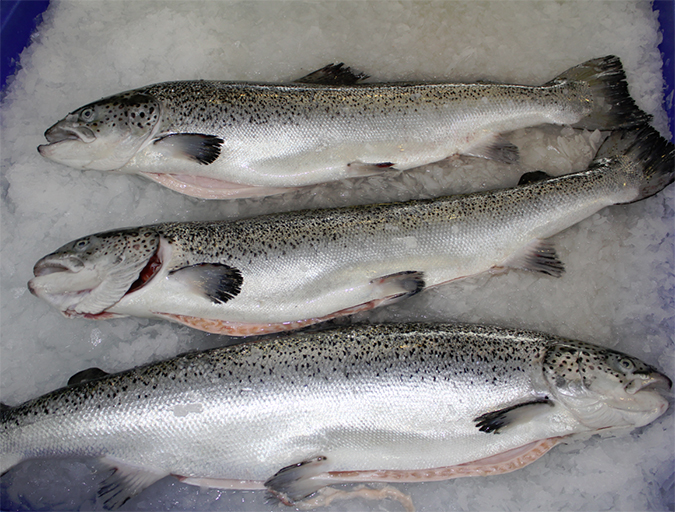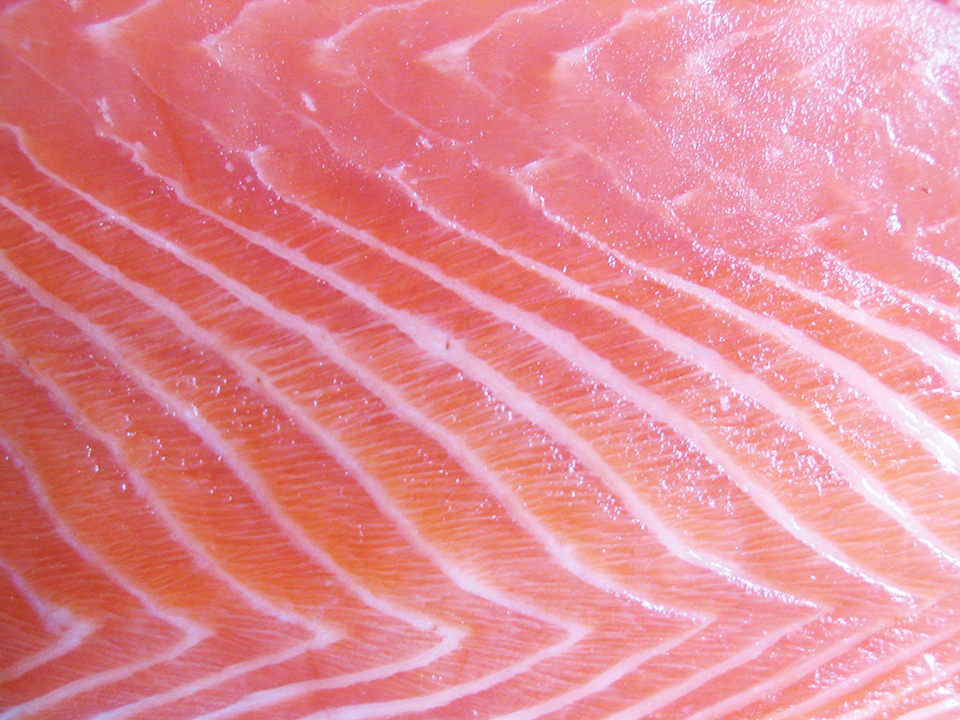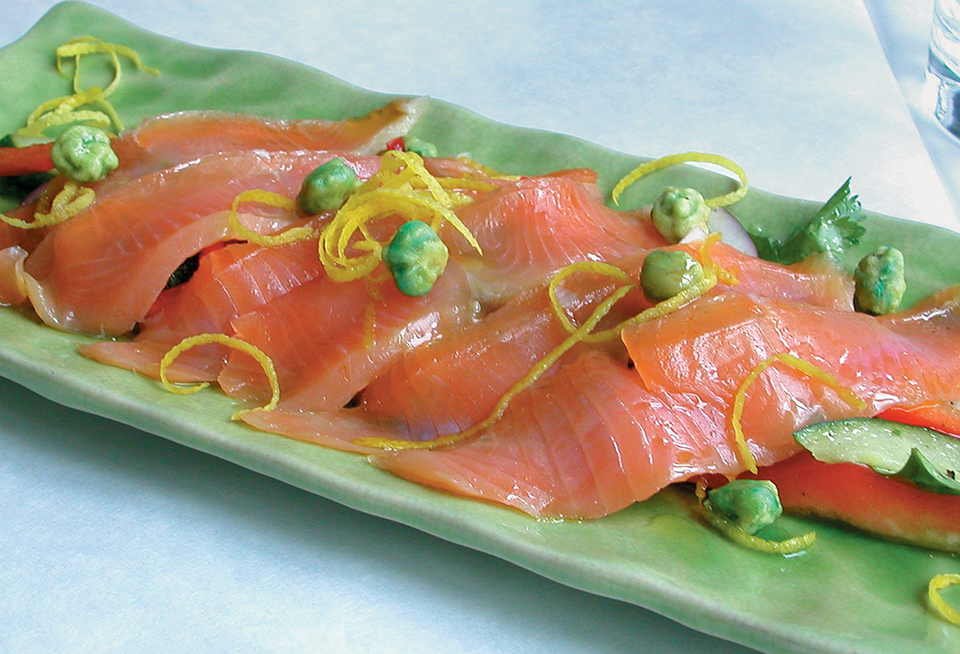Fillets measured for yield, organoleptic qualities, composition, salt content, texture

Since ancient times, smoking has been used to preserve food products and improve their taste, aroma, and color. Preservation of fish by smoking typically involves using large amounts of salt and low-humidity conditions during the process, with subsequent removal of the salt when the fish is to be consumed. Sensorial and nutritional qualities determine the acceptability of smoked fish, and different processing methods produce a variety of products.
Two smoking processes
In hot smoking, the smoking chamber temperatures range 50 to 90 degrees-C, while in the cold-smoking process, the temperatures are 30 to 40 degrees-C. It is very important that temperatures are not excessive during the draining and drying stages of the hot-smoking process, because total protein denaturing could occur and the fish flesh would harden due to water evaporation from its upper surface layers.
Beyond temperature, the main other difference between the processes is related to the fate of fish proteins after smoking. In hot smoking, changes occur by the denaturing of proteins due to high temperature. In cold smoking, enzymes make the flesh edible.
Taste and shelf life
Changes in temperature and duration favor different organoleptic characteristics and the shelf life of the final smoked product. Hot smoking gives its products a pleasing aroma, taste and color. Cold smoking, which exposes fish to aromatic smoke longer than the hot-smoking process, is typically used for preservation purposes.
The external appearance of smoked products is an important characteristic for buyers. An improvement in the color of smoked fish occurs either by the addition of natural coloring or extending the smoking time. Artificial coloring usually produces greater color uniformity. Extended smoking causes a greater weight loss, which can affect profitability.
Smoking tests
The authors recently assessed the effects of smoking techniques on fillets of Nile tilapia (Oreochromis niloticus). Fillets with (FCP) and without (FSP) pigmentation were measured for yield, organoleptic qualities, composition, salt content and texture.
For the tests, 250 fish of about 600 grams each were sacrificed by cold shock, weighed and filleted. The fillets were identified with a metal tag and weighed to determine yield, then immersed in a 20 percent brine solution for 30 minutes.
Fillets in the pigment treatment were immersed in a solution of .6 percent annatto extract at 1 kg fish:1 l solution for 15 minutes. The annatto or “lipstick tree” is a plant rich in red pigments that is commonly used to color and flavor many foods in Central and South America. Cold (30 to 40 degrees-C) and hot (50 to 80 degrees) smoking followed for five and three hours, respectively.
The smoked fillets were used in a sensorial test involving 45 nontrained testers who graded the fillets from 0 for least liked to 9 for best liked for several test parameters. Fillet samples were also measured to determine percent composition, calculation of chlorides, and texture. Eighty-five fillets per treatment were used to calculate yield. Fillet color was determined with a portable colorimeter. Additional details on these tests are available from the authors.
Results
Hot-smoked fillets had lower (P < 0.01) yield than the cold-smoked fillets. There were also significant (P < 0.01) interactions in smoked fillet yield. Regarding the interaction between smoking technique and pigmentation, cold smoke processing produced higher yields, regardless of whether fillets were pigmented (FCP = 24.90 percent) or not (FSP = 25.03 percent). Pigmented fillets processed by hot smoking had higher (23.85 percent) yield than nonpigmented fillets (22.20 percent). The lowest yields were due to the high weight loss of fillets during the smoking process, which caused dehydration and lixiviation of lipids in the muscle tissues.
Nonpigmented fillets had higher (3.12 percent) chloride concentrations than the pigmented fillets (2.55 percent). A dilution of chloride rate may have occurred with pigmentation and dehydration by temperature and duration of the smoking process.
Hot-smoked fillets had lower humidity (68.90 percent), higher crude protein (25.20 percent), and higher ash content (3.85 percent percent) than cold-smoked fillets, with their respective values of 72.24, 22.50 and 3.19 percent. The lipid values for both processes were about 2.10 percent. Pigmentation did not affect the composition of the smoked fillets, except for higher ash and salt content in the pigmented fillets.
Taste test
Hot-smoked fillets received better marks regarding their taste, aroma, texture, and color when compared to the cold-smoked fillets (Table 1). Pigmented fillets received higher marks for coloration than the nonpigmented fillets, but there were no differences in aroma and texture. However, taste was reportedly better in nonpigmented fillets, which had more chloride.
De Souza, Mean values (transformed by √x + 0.5) given by test panel, Table 1
| Presentation | Salt | Color | Flavor | Odor | Odor |
|---|---|---|---|---|---|
| Cold smoking | 2.90a | 2.34b | 2.23b | 2.33b | 2.27b |
| Hot smoking | 2.77a | 2.34b | 2.78a | 2.64a | 2.77a |
| With pigment | 2.55b | 2.62a | 2.45b | 2.46a | 2.46a |
| Without pigment | 3.11a | 2.36b | 2.57a | 2.51a | 2.55a |
| F Test | |||||
| Technique (T) | 0.315ns | 31.47** | 116.88** | 43.93** | 99.94** |
| Pigmentation (P) | 5.59* | 23.42** | 5.35* | 1.31ns | 2.68ns |
| (T x P) | 5.01ns | 0.21ns | 2.30ns | 0.64ns | 1.70ns |
| C.V. (%) | 11.80 | 13.47 | 12.85 | 11.80 | 13.50 |
Table 1. Mean values (transformed by √x + 0.5) given by test panel for organoleptic characteristics of smoked tilapia fillets. Values with the same letter were not significantly different (Tukey’s test, P = 5 percent).
The hot-smoking process produced fillets with greater softness, based on texture meter results of 2.71 for FCP and 3.09 for FSP. Texture for the cold-smoked fillets was measured at 6.40 for FCP and 6.11 kg for FSP. Although greater (13.51 percent) losses occurred during the hot smoking than the cold (11.53 percent), the hot-smoked fillets with pigmentation were better regarded by testers.
(Editor’s Note: This article was originally published in the December 2003 print edition of the Global Aquaculture Advocate.)
Now that you've reached the end of the article ...
… please consider supporting GSA’s mission to advance responsible seafood practices through education, advocacy and third-party assurances. The Advocate aims to document the evolution of responsible seafood practices and share the expansive knowledge of our vast network of contributors.
By becoming a Global Seafood Alliance member, you’re ensuring that all of the pre-competitive work we do through member benefits, resources and events can continue. Individual membership costs just $50 a year.
Not a GSA member? Join us.
Authors
-
Maria Luiza Rodrigues de Souza, Ph.D.
Department of Animal Science
State University of Maringá
Avenida Colombo 5790
87020-900 Maringá, PR Brazil[114,98,46,109,101,117,64,97,122,117,111,115,114,108,109]
-
Elisabete Maria Macedo Viegas, Ph.D.
Department of ZAZ of the FZEA
University of São Paulo-USP
Pirassununga, SP, Brazil
Related Posts

Innovation & Investment
Africa’s first land-based salmon farm a landmark for Lesotho
A Singapore-based company aims to make Lesotho, a nation of 2 million people, known for a local fish that’s truly anything but local: Atlantic salmon.

Health & Welfare
Aquaculture viruses: An Atlantic salmon case study
Viruses often are the most potentially damaging pathogens in nature, affecting both wild stocks and farmed animals. Due to an Infectious Haematopoietic Necrosis (IHN) viral outbreak that occurred in Atlantic salmon in British Columbia, Canada some years ago, a vaccine for IHN was developed against this serious threat.

Intelligence
All about Listeria
The pathogenic bacterium Listeria monocytogenes is present in the environment and easily transferred to food and food contact surfaces.

Intelligence
Fat content, freezing affect cold-smoked salmon quality
Product quality in cold-smoked salmon is best maintained by smoking fresh fish with high fat content and freezing them after, not before, smoking.


